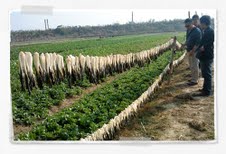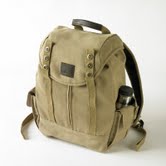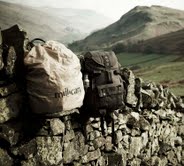VOICES // a feature space on SA where community members are invited to share their journey in responsible design. This post was written by Jorrit Jorritsma, Co-Founder of Millican, and tells the story of the joys and challenges they face on their journey toward eco-innovation. What’s your story?
THE JOYS AND CHALLENGES OF RUNNING AN ECO-INNOVATIVE COMPANY
As someone who runs an eco-innovative company, I’m aware of the great interest that such businesses have for many people at this time. Social Alterations itself does a huge amount to promote awareness of this growing trend. So I thought it would be interesting to share some thoughts about the ideals and day-to-day realities that can inform such a company.
Today, my wife, Nicky, and I run our own brand, Millican – a company that produces made modern travel bags inspired by classic styles, largely made with sustainable materials. We hope that sharing our story and choices encourages our customers to make their own conscious decisions about sustainability and eco-friendly living.
Our shared values permeate our company ethos. However, our primary incentive for starting the company came as a reaction to our previous working lives.

HOW MILLICAN STARTED
Prior to Millican, I oversaw global operations for Kangol Headwear, fulfilling work but a job increasingly demanding in terms of work-life balance. After Nicky and I swapped city life for a home in the Lake District, foreign work travels seemed additionally arduous. I began to feel – if I’m investing all this time in work, wouldn’t it be wonderful to build something myself?
From early childhood, I’d been passionate about travel and travel bags, having spent hours digesting tales about Victorian adventurers and explorers. Moreover, Nicky and I had been inspired for years about three things – outdoor life, travel, and connecting with other people. So the seed for producing our own travel bags always lay there dormant.
At the same time, overseeing increased turnaround times on fashion trends at Kangol left me feeling internally conflicted, given my heart for sustainability. I loved the creativity of the fashion world but wanted to see that creativity channeled in a more sustainable direction.
 Another inspiration on our doorstep was the example of Millican Dalton (after whom our company is named), a man who had given up London life as an insurance clerk in the early 1900’s to forge an alternative, sustainable life in the Lakes. Millican Dalton’s passion for nature, eco-friendly living, and shared adventuring became a compelling new influence on us.
Another inspiration on our doorstep was the example of Millican Dalton (after whom our company is named), a man who had given up London life as an insurance clerk in the early 1900’s to forge an alternative, sustainable life in the Lakes. Millican Dalton’s passion for nature, eco-friendly living, and shared adventuring became a compelling new influence on us.
From this amalgam of influences, our company Millican was born. Drawing on classic styles like the Gladstone bag, we wanted to produce bags combining vintage style and contemporary flair for the modern market. Our dream has also been to create a business that encourages a level of awareness about sustainability in our customers. Through our company, we’re hoping to generate a story-telling forum that contributes to the increasing conversation about business, brands, corporate social responsibility and sustainability.
WHAT ARE THE CHALLENGES OF CREATING A SUSTAINABLE BRAND?
“Through our company, we’re hoping to generate a story-telling forum that contributes to the increasing conversation about business, brands, corporate social responsibility and sustainability.” (Jorrit Jorritsma, Co-Founder of Millican)
Being open on our website about our organic and recycled materials and ethical production processes hopefully raises the level of conversation with our customers and leads them to be more conscious about their choices. However, the challenges of running an eco-innovative company are legion. In our case, we pump a lot of effort into sourcing organic fabric for our overnight bags, vegetable tanned leather for our wallets, and recycled polyester for our rucksacks. Having said all that, it’s worth being clear that 100% sustainability doesn’t exist.
However natural the materials that a company uses, those materials still need to be produced, processed and shipped. And that involves energy, fuel emissions, and a carbon footprint. We’ve therefore discovered that it’s all about degrees of sustainability.
It also involves our making subtle ethical choices on a daily level. Is it better to draw on partners in Hong Kong and China with excellent access to organic materials and commendable ethical working practices? Or to use a local supplier with less of an organic track record? Should we work with larger companies that are tried and tested or privilege smaller organizations and individuals who come with less of a track record but who are high on values of personal integrity?
 In terms of our production team, we’ve ended up working with both UK-based craftsmen and partners further afield. Closest to home, we’ve dragged our “Dame of Sewing” Vera out of Kangol-retirement to help us with our cooler bags and drinks coolers. Vera was one of Kangol’s most experienced milliners, and in fact their last remaining UK milliner at that. We bought a reconditioned industrial sewing machine, which Vera uses to prepare the insulated lining before finishing off the cooler products when they come in from a family-run factory in China.
In terms of our production team, we’ve ended up working with both UK-based craftsmen and partners further afield. Closest to home, we’ve dragged our “Dame of Sewing” Vera out of Kangol-retirement to help us with our cooler bags and drinks coolers. Vera was one of Kangol’s most experienced milliners, and in fact their last remaining UK milliner at that. We bought a reconditioned industrial sewing machine, which Vera uses to prepare the insulated lining before finishing off the cooler products when they come in from a family-run factory in China.
 Although we originally sampled our bags with another UK manufacturer, John Chapman in Carlisle, we found it impossible to make this commercially viable. A real shame. Having said that, we’ve since found a fantastic partner in Henry Law and his small team in southern China. Henry has been very supportive from the start, and keen to continue to upgrade his business with the use of organic and recycled materials and practices. He also farms, providing the vegetables for his own team as well as various factories around him. And he is mad about tea, as I am!
Although we originally sampled our bags with another UK manufacturer, John Chapman in Carlisle, we found it impossible to make this commercially viable. A real shame. Having said that, we’ve since found a fantastic partner in Henry Law and his small team in southern China. Henry has been very supportive from the start, and keen to continue to upgrade his business with the use of organic and recycled materials and practices. He also farms, providing the vegetables for his own team as well as various factories around him. And he is mad about tea, as I am!
 In terms of the materials we use for our bags, working with RITE (Reducing the Impact of Textiles on the Environment), we feel that we’ve made some real strides. For example, using organic cotton rather than its conventional cousin, since the former involves far less pesticides, insecticides and water in its production. And, even with synthetic materials, using recycled polyester rather than virgin polyester, saving 50% on water, 20% on energy, and 60% on air pollution.
In terms of the materials we use for our bags, working with RITE (Reducing the Impact of Textiles on the Environment), we feel that we’ve made some real strides. For example, using organic cotton rather than its conventional cousin, since the former involves far less pesticides, insecticides and water in its production. And, even with synthetic materials, using recycled polyester rather than virgin polyester, saving 50% on water, 20% on energy, and 60% on air pollution.
However, not all our materials are organic or recycled at present. Our bags can each contain as many as fifteen components. And in some cases, we simply haven’t yet found a more sustainable alternative, or alternatives are too expensive at this point in our growth. So it’s always a matter of balancing the ideal and the realistic.
HOW DID WE GET TO OUR PRESENT COLLECTION?
 Prior to Millican, I had never designed anything. Doodled a lot, but never designed a thing. So I began with Dave, the rucksack. Inspired by the original framed Bergen packs, I see this as the central product around which our whole range subsequently developed. We’re now finalising its smaller brother, Matthew the daypack, for July 2010.
Prior to Millican, I had never designed anything. Doodled a lot, but never designed a thing. So I began with Dave, the rucksack. Inspired by the original framed Bergen packs, I see this as the central product around which our whole range subsequently developed. We’re now finalising its smaller brother, Matthew the daypack, for July 2010.
First and foremost, we want consumers to be attracted to our products because they love the way our bags look. Once they’ve explored the bags’ features, we want them to admire them for their practicality and functionality. The fact that the products are made from sustainable materials in an ethical way supports their purchase but is not aimed to be the primary motivator. Being a twenty-first century brand, we believe that we couldn’t have created products with anything other than sustainability in mind. So the sustainable dimension is, for us, a given rather than a much-heralded feature.
Having said that, as far as the Millican brand goes, every product that we design and manufacture has to meet our own personal wish-list:
1. Our bags needs to be based on classic, proven utility shapes and styles that have stood the test of time and will continue to do so in the future. Heirloom design, as it’s known – products that you should be able to pass down to your grand-children in time, such are their enduring appeal.
2. They then need to include all the features and functionality that one expects not only for the purpose (e.g. a rucksack with waterproof recycled poly cover) but also for contemporary living (e.g. pouches and pockets for computer, iPod and phone).
3. They have to be made using materials that are as sustainable as possible, ensuring optimal quality and performance. This might mean weatherproof heavy-duty organic cotton canvas for the outer fabric of our bags; waterproof recycled polyester for the lining and outer cover of our rucksack, daypack and wash bags; and brushed organic cotton for the lining of our overnight and shoulder bags.
4. Above all, they have to be multi-use products. We simply don’t believe in luxury bags that only have one application. Stewart our courier bag makes a great day bag but also a useful small overnight bag. And Dave the rucksack is a fully-equipped walking pack equally at home in the mountains or on the daily urban commute to work. Ensuring our bags include many features for many uses puts them, we believe, ahead of the market and means our customers have no need to buy additional products other than for added pleasure.
Our range includes:
Dave the rucksack (all our products are named after our inspiring friends up here in the Lakes!) is the grand-daddy of our collection, a direct link back to Millican Dalton who used to make his own rucksacks. This is a true Lakeland pack, though highly functional in an urban environment as well as up on the fells.
Mark the field bag is a shoulder bag to complement Dave, ideal for everyday use and travel.
Stewart the courier bag is again, a shoulder bag but large enough for overnight use or as a substantial work bag. You can happily carry a laptop, papers, and plenty else inside. Harry the Gladstone bag is our overnight / weekend bag, inspired by the Victorian Gladstone classic and perfect as hand luggage for air travel too.
And then there’s our other products. Les the cooler bag – big enough to accommodate various food containers plus a few bottles of wine for a picnic or day out. Les is insulated with Herdwick sheep wool from the farm closest to the cave that Millican Dalton inhabited for most of his Lakeland life. And two toiletry bags (Peter, the doctor’s wash bag, and Jonathan, the wash roll), two food-grade, stainless steel drinks bottles Andy & Simon, a Herdwick wool insulated drinks cooler Derek and three hand-made, oak bark tanned bridle leather wallets and Matt the Moleskine leather cover. All in all, enough for a comprehensive personal travel collection.
WHERE DOES AN ECO-INNOVATIVE COMPANY LIKE OURS GO NEXT?
We’ve got loads of plans. We want to keep growing our bag base, always from a starting point of functional inspiration. This Spring, we’ve had fifteen design ideas on the table and have been doodling like crazy. Our new products to be launched in July include a new daypack, a waistpack and a holdall.
 We suspect that much of the way we develop will also spring from our collaborations. We’re pursuing a few ideas at present – including options for a Millican canvas tent, and a bike based on the original blue bike that Millican Dalton used for cycling and camping trips in his youth. In the last two months, we’ve reconditioned a bike fusing a 1947 Raleigh Clubman frame design with contemporary functionality. I’ve just ridden this bike as part of the Keswick Mountain Festival Sportive, an unforgettable experience that has certainly left me thinking about future bike possibilities.
We suspect that much of the way we develop will also spring from our collaborations. We’re pursuing a few ideas at present – including options for a Millican canvas tent, and a bike based on the original blue bike that Millican Dalton used for cycling and camping trips in his youth. In the last two months, we’ve reconditioned a bike fusing a 1947 Raleigh Clubman frame design with contemporary functionality. I’ve just ridden this bike as part of the Keswick Mountain Festival Sportive, an unforgettable experience that has certainly left me thinking about future bike possibilities.
Then, if we can make some limited edition products inspired by Millican Dalton’s lifestyle, it will make us very happy. Perhaps our own brand of coffee? Millican was an avid coffee drinker, and celebrated his 50th ascent of Napes Needle by brewing a pot of coffee on the summit. Scary when you see how steep this climb is and how little room on the top.
We’d also love to apply our design philosophy to a small clothing and clothing accessories range in 2011/12. Millican Dalton used to make his own clothes from staple British fabrics like cord and moleskin. When I visited fabric supplier Brisbane Moss, they were certain it would have been their moleskin that Millican would have used over a century ago. It will be fascinating to see what we might do starting from a similar premise. I take a lot of inspiration from brands like albam, Folk, Universal Works and howies, although Millican’s background will allow us to create our own distinctive style.
Having just secured our first order from Selfridges for their Oxford Street flagship store in London, finding strong imaginative retailers is high on our “to do” list. Partners who prize the functional, collaborators in menswear, as well as ‘special interest’ retailers like galleries, reclamation yards, and bookshops.
So we see huge potential for expanding our range, while remaining true to our initial inspirations, aesthetics, and belief in ethical production and sustainability. Provided that we don’t get overwhelmed running our home-grown company and remember to get into the great outdoors we produce all our products for, we should just about stay sane enough for plenty of years of eco-innovative adventuring to come!
Jorrit Jorritsma,
Co-Founder,
Millican







Great piece by a great brand. Kudos all around.